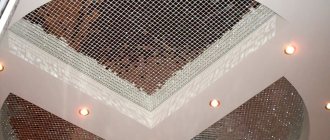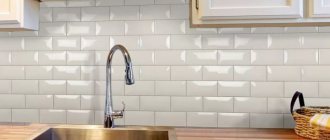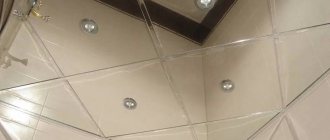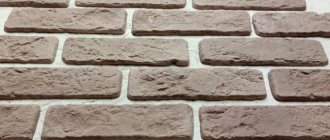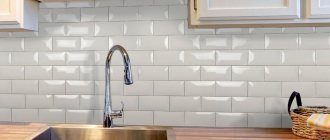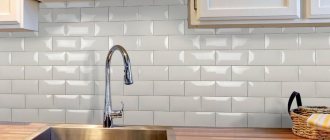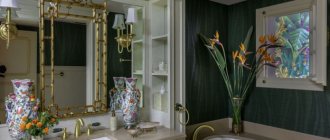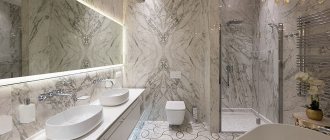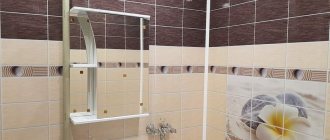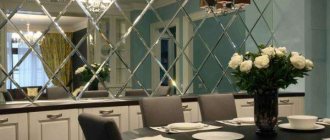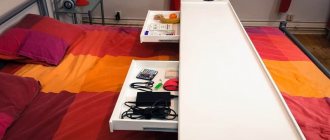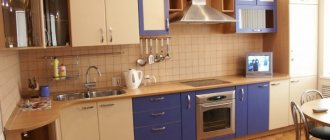When deciding what and how to diversify the interior, more and more people are choosing mirror mosaics. And not without reason, because this method of finishing is now very relevant. With its help, the room takes on a truly magical and amazing character. An interior decorated with such mosaics always has a festive and solemn look. Even very insignificant mirror fragments can add a “zest” to the room, not to mention the continuous decoration of walls or ceilings with mosaics.
Pros and cons of use in the interior
Pieces of mirrors have long been used in interior decoration. Previously, a mosaic panel could be made from fragments of a broken mirror. Modern mosaics are made from particularly durable material. It has proven itself to be the best due to its features:
| Advantages | Flaws |
| It is resistant to abrasion and does not lose its shine over time. | If the mosaic is not fixed to the grid, but consists of individual parts, installation takes a lot of time and effort. |
| It is environmentally friendly, and is not afraid of moisture and aggressive detergents. | If a room decorated with mosaics is not ventilated, under the influence of moisture the canvas fogs up and darkens. |
| Strong and durable material, temperature changes do not affect it in any way. |
Mirror mosaic finishing options
Mirror mosaic is a truly universal material. It looks great on any surface: walls, ceilings and even interior items - furniture, fireplaces, mirrors. Adding mirror strips or inserts to the decoration will help transform the space of the apartment. Installation of tiles attached to the mesh is easy: the canvas is glued to the prepared surface. The grout can be white or graphite in color.
Kitchen apron
Because of its advantages, a mirror panel is often installed in the kitchen as an apron. This decor not only expands the space, but also protects the wall from dirt in the cooking area.
Walls
The surface finished with mirror mosaic is very practical, so it can be tiled in any corner of the house: kitchen, bedroom, living room. This decor looks great in hallways and can also decorate a bathroom.
The photo shows a bathroom in a minimalist style. The interior is enlivened by a wall of combined mosaic tiles that form a pattern.
Ceiling
It is recommended to decorate part of the ceiling with mosaic tiles to avoid overcrowding the interior. The area where the chandelier hangs is successfully decorated: its mirror surface reflects light and casts picturesque reflections on the walls. The mosaic edging laid around the perimeter of the ceiling looks original - it increases the amount of daylight coming from the windows.
Wardrobe facade
You can decorate almost any furniture with mirror fragments: tables, cabinets, kitchen islands, bar counters. The façade of the wardrobe, decorated with mosaics, looks extraordinary.
The photo shows a wardrobe with a door decorated with mirror squares. Diagonal laying echoes the floor covering, and beveled edges make the interior richer.
Frame for a picture or mirror
Interior items decorated with mosaics always look stylish and original. You can make such a mirror with your own hands by gluing mosaic pieces to any surface.
Niche
A niche decorated with mini-mirrors will become the “highlight” of the interior, visually enlarging it and attracting the attention of guests.
The photo shows a fragment of a kitchen with a niche decorated with thin shiny stripes that visually deepen the space.
Fireplace
Mosaic is resistant to high temperatures and, despite its external fragility, is very durable. This coating is ideal for cladding a fireplace portal.
From fabric
Almost any material available in your home is suitable for making fabric panels, be it burlap, felt, chintz or even silk.
There are many ways to create a fabric panel. Some of them are suitable even for beginners, while others are only suitable for professionals. Let's consider the simplest options.
Felt
It’s not at all difficult to make a cute panel from multi-colored felt. To do this you need:
- draw or print a suitable picture from the Internet (for example, funny animals);
- prepare stencils of animals by transferring their images from the picture onto thick cardboard and then cutting them along the contour with scissors;
- mark the patterns on the fabric by tracing the cardboard figures with a pencil;
- cut out the blanks along the contour and glue them to the base in accordance with the selected picture.
Sackcloth
Quite often used as a decorative element or the basis for wall panels.
By stretching a piece of burlap over a beautiful, decorated frame, you can get the simplest panel.
Decorative elements made from burlap - flowers, ribbons, bows - will be appropriate in an interior decorated in eco-style or rustic style.
Fabric with a pattern
You can make a wall panel using the batik technique by drawing the intended design on the fabric with acrylic paints. Then the material should be pulled onto the frame, secured on the back side with a stapler.
From ceramic tiles
Not the fastest way to create a panel, requiring perseverance and painstakingness. But the result can be truly magnificent.
- Multi-colored fragments of ceramic tiles are cut into small elements with a glass cutter.
- The base is cleaned of dirt and dust, and the selected design is applied to it with a pencil.
- Then the prepared elements are glued to the “liquid nails” in accordance with the pattern according to color, leaving gaps of approximately 2.5 - 5 mm between them.
- If desired, you can add other decorative elements to the composition (shells, beads, pebbles).
- After the entire picture has been laid out, a special grout is applied to it with a rubber spatula. It fills the previously left gaps between the mosaic pieces.
- Excess grout is removed with a damp sponge, the panel is dried for several hours, then placed in the prepared place.
From photographs
Family photos don't have to gather dust in an album. You can use them to make a wonderful wall panel that will decorate the interior of your living room and remind you of the happy moments of your life.
There are different options for this panel.
You can buy several frames of different shapes and place them on the wall in a chaotic order, of course, having previously inserted photographs into them.
You can make a frame yourself in the shape of a square or rectangle, divided by slats into smaller rectangles in which to place photographs.
You can simply create a collage of photos on the wall, connecting them in any order without any frames. The photographs do not have to be yours; you can take artistic photos.
From the mirrors
Mirror panels have recently become increasingly popular.
If you are not afraid of difficulties, then you can try to make a mirror panel on the wall with your own hands. However, this is not at all an easy task.
Some mirror processing operations are simply impossible to perform at home. For example, you cannot make a bevel on a mirror yourself; this requires a special machine.
Therefore, the most reasonable solution would be to order the production of mirror tiles from a glass and mirror company. There, parts of the panel will be cut out according to your sketch and dimensions, the edges will be processed, the parts will be numbered, and then you can paste them on your wall.
Mosaic tile design ideas and shapes
Modern mosaic is represented by a wide range. Types of mirror tiles differ in the type of processing, shape, shades and size.
- The edges of products are processed in different ways: the surface can be ground or polished. A bevel is also used, which gives the tiles additional volume.
- On sale there are not only square-shaped products, but also in the form of rhombuses, rectangles, and hexagonal honeycombs. Round tiles are particularly original.
- To diversify the usual “silver” mirror shade, manufacturers have learned to tint products to look like black mirror, bronze and gold.
The photo shows a bathroom in which the space is uniquely expanded due to combined mirror parts of different sizes.
The mosaic also differs in its size: from small (10x10 mm) to large (several centimeters in area).
Tips for choosing
Think in advance about the design of the room and how you will use the mosaic. If you do not use polymer modules, but loose mosaics of arbitrary shape and size, this is even more important to do. The refraction of light from such a mosaic will be chaotic, so do not overdo it.
- If you are decorating the ceiling in a room, then the walls should be in subdued colors and not overloaded with decor. A mirrored ceiling will reflect on the walls, so there is no need to visually overload them.
- If there are mirror fragments on the ceiling, also choose the right lighting that will highlight the advantages of such cladding.
In this video about all kinds of mirror mosaics and suitable adhesive compositions
Photos in the interior of the rooms
Mirror canvases have always added solemnity to the interior and expanded the space. Mosaic tiles look impressive, and most importantly, they provide ample opportunities for creativity: they can be combined with other materials, combine different sizes and shapes, and create shaped compositions.
In the kitchen
The mirror finish goes well with the chrome surfaces of the cookware. If the kitchen is combined with the living room, such an apron will become an additional decoration of the interior.
The photo shows a kitchen with a figured mosaic in the form of a hexagonal honeycomb.
In the bathroom and toilet
Small rooms will become wider and brighter if you decorate them with mosaics. Usually one wall or element of the bathroom is allocated for this: a countertop, a shower stall or an area where the mirror is located.
In the bedroom
A composition of mini-mirrors can be placed at the head of the bed or opposite the bed. In a small room, vertical panels would be appropriate. Thanks to this interesting technique, the bedroom can be made visually higher.
The photo shows a futuristic bedroom interior with an accent wall completely lined with mirror mosaic.
DIY installation
You can make jewelry from mirrors with your own hands
It is important to remember that cutting a mirror is difficult. It is better not to choose complex patterns if you have no experience in cutting glass elements
The edge of mirrors is difficult to process; it is not always even and smooth. The order of work is step by step:
It is necessary to determine the location of the decorative panel. Choose a design. Before starting work, read the instructions, choose the right glue and purchase the necessary tools. It is important to carefully prepare the surface
It must be absolutely even, otherwise distortions will be noticeable and reflections will be distorted. Markings are applied to the wall. The panels are glued to the wall according to the manufacturer’s diagram. If required, the mirrors are cut to the required size with a glass cutter. This must be done very carefully so that the parts do not crack. To glue mirrors you need to use high-quality glue.. https://www.youtube.com/embed/p5qYOaNsGqg
There are workshops where you can order all the necessary elements.
Everyone chooses mirrors according to their taste so that they fit harmoniously into the interior of the room. But it is necessary to remember that the mirror must be carefully looked after; dust, dirt and stains are always visible on it. Especially if it is located in the kitchen.
In the corridor and hallway
The use of mosaics in the hallway is due not only to decorative considerations, but also to the small area of the premises. Furniture and panels with mosaic elements are appropriate in the corridor. And if you decorate a spacious hall with shining squares, this will favorably emphasize its royal size.
In the living room
The interior of the living room, decorated with mosaics, acquires a special charm.
The photo shows a living room decorated with stripes of mini-mirrors. Such illuminated architectural elements serve a decorative function, unifying the space.
What to combine mirror mosaic with?
Mirror mosaic is a universal decorative item that looks good in combination with many materials. Most often it is combined with glass or plastic mosaics and ceramic tiles.
The photo shows an elegant combination of light tiles and mirror details that resemble streams of water and add individuality to an ordinary interior.
